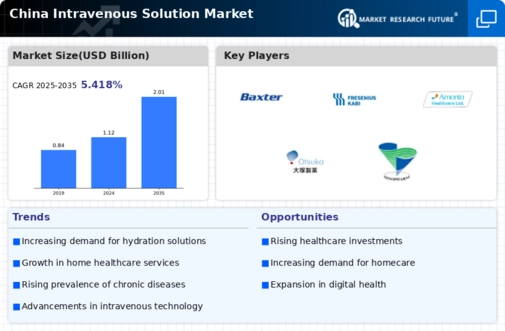Increasing Healthcare Expenditure
The intravenous solution market in China is experiencing growth due to rising healthcare expenditure. The Chinese government has been increasing its investment in healthcare, which has led to improved access to medical facilities and services. In 2023, healthcare spending in China reached approximately $1.2 trillion, reflecting a growth rate of around 10% annually. This increase in funding allows hospitals and clinics to procure advanced intravenous solutions, enhancing patient care. Furthermore, as the population ages, the demand for intravenous therapies is likely to rise, contributing to the expansion of the intravenous solution market. The focus on improving healthcare infrastructure and services indicates a positive outlook for the market, as more patients gain access to necessary treatments and therapies.
Expansion of Healthcare Facilities
The intravenous solution market is benefiting from the expansion of healthcare facilities across China. The government has initiated various programs aimed at enhancing healthcare infrastructure, particularly in rural and underserved areas. By 2025, it is projected that the number of hospitals in China will increase by approximately 15%, leading to greater demand for intravenous solutions. This expansion not only improves access to healthcare but also increases the volume of intravenous therapies administered. As more healthcare facilities are established, the intravenous solution market is likely to see a corresponding rise in demand, driven by the need for effective treatment options in these newly developed institutions.
Rising Incidence of Chronic Diseases
The intravenous solution market is significantly influenced by the rising incidence of chronic diseases in China. Conditions such as diabetes, cardiovascular diseases, and cancer are becoming increasingly prevalent, necessitating effective treatment options. According to recent statistics, chronic diseases account for over 80% of deaths in China, highlighting the urgent need for medical interventions. Intravenous solutions play a crucial role in the management of these conditions, providing essential nutrients and medications directly into the bloodstream. As healthcare providers seek to improve patient outcomes, the demand for intravenous therapies is expected to grow. This trend suggests a robust future for the intravenous solution market, as healthcare systems adapt to the increasing burden of chronic diseases.
Growing Awareness of Nutritional Support
There is a growing awareness of the importance of nutritional support in medical treatments, which is positively impacting the intravenous solution market. Healthcare professionals in China are increasingly recognizing the role of intravenous nutrition in patient recovery, particularly for those undergoing surgery or suffering from severe illnesses. This shift in perspective is leading to a higher adoption rate of specialized intravenous solutions designed for nutritional support. As hospitals and clinics prioritize comprehensive patient care, the demand for these solutions is expected to rise. This trend indicates a promising future for the intravenous solution market, as healthcare providers seek to enhance patient outcomes through improved nutritional interventions.
Advancements in Pharmaceutical Manufacturing
Advancements in pharmaceutical manufacturing technologies are driving innovation within the intravenous solution market. In China, the development of more efficient production processes has led to the creation of high-quality intravenous solutions that meet stringent regulatory standards. These advancements not only improve the safety and efficacy of intravenous therapies but also reduce production costs. As a result, healthcare providers are more likely to adopt these solutions, contributing to market growth. The focus on quality and efficiency in manufacturing suggests that the intravenous solution market will continue to evolve, with new products and formulations emerging to meet the diverse needs of patients and healthcare providers.
















Leave a Comment